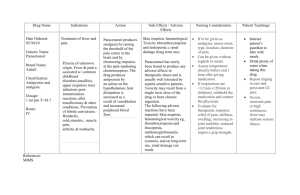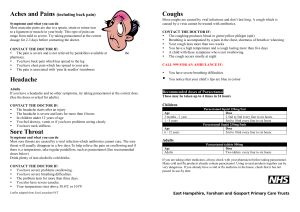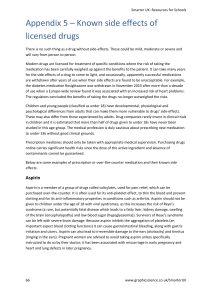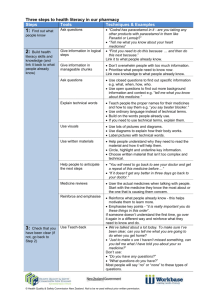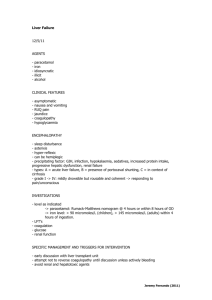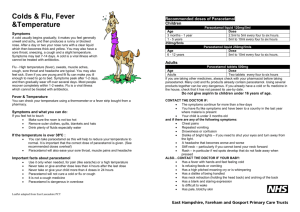Document 13309729
advertisement
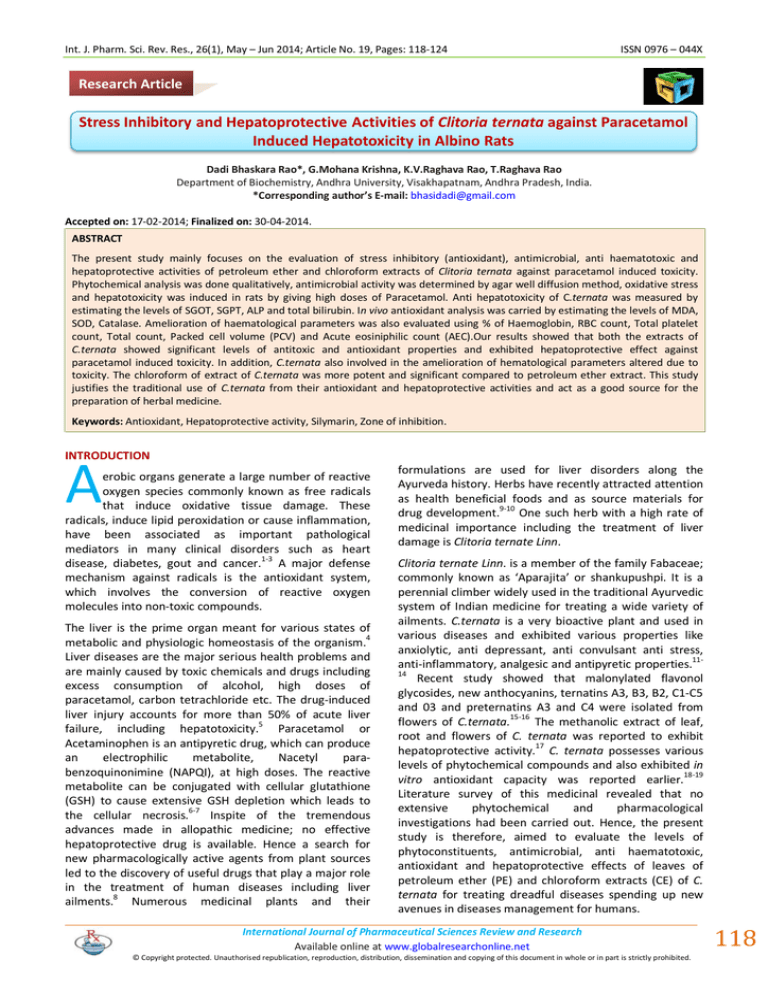
Int. J. Pharm. Sci. Rev. Res., 26(1), May – Jun 2014; Article No. 19, Pages: 118-124 ISSN 0976 – 044X Research Article Stress Inhibitory and Hepatoprotective Activities of Clitoria ternata against Paracetamol Induced Hepatotoxicity in Albino Rats Dadi Bhaskara Rao*, G.Mohana Krishna, K.V.Raghava Rao, T.Raghava Rao Department of Biochemistry, Andhra University, Visakhapatnam, Andhra Pradesh, India. *Corresponding author’s E-mail: bhasidadi@gmail.com Accepted on: 17-02-2014; Finalized on: 30-04-2014. ABSTRACT The present study mainly focuses on the evaluation of stress inhibitory (antioxidant), antimicrobial, anti haematotoxic and hepatoprotective activities of petroleum ether and chloroform extracts of Clitoria ternata against paracetamol induced toxicity. Phytochemical analysis was done qualitatively, antimicrobial activity was determined by agar well diffusion method, oxidative stress and hepatotoxicity was induced in rats by giving high doses of Paracetamol. Anti hepatotoxicity of C.ternata was measured by estimating the levels of SGOT, SGPT, ALP and total bilirubin. In vivo antioxidant analysis was carried by estimating the levels of MDA, SOD, Catalase. Amelioration of haematological parameters was also evaluated using % of Haemoglobin, RBC count, Total platelet count, Total count, Packed cell volume (PCV) and Acute eosiniphilic count (AEC).Our results showed that both the extracts of C.ternata showed significant levels of antitoxic and antioxidant properties and exhibited hepatoprotective effect against paracetamol induced toxicity. In addition, C.ternata also involved in the amelioration of hematological parameters altered due to toxicity. The chloroform of extract of C.ternata was more potent and significant compared to petroleum ether extract. This study justifies the traditional use of C.ternata from their antioxidant and hepatoprotective activities and act as a good source for the preparation of herbal medicine. Keywords: Antioxidant, Hepatoprotective activity, Silymarin, Zone of inhibition. INTRODUCTION A erobic organs generate a large number of reactive oxygen species commonly known as free radicals that induce oxidative tissue damage. These radicals, induce lipid peroxidation or cause inflammation, have been associated as important pathological mediators in many clinical disorders such as heart disease, diabetes, gout and cancer.1-3 A major defense mechanism against radicals is the antioxidant system, which involves the conversion of reactive oxygen molecules into non-toxic compounds. The liver is the prime organ meant for various states of metabolic and physiologic homeostasis of the organism.4 Liver diseases are the major serious health problems and are mainly caused by toxic chemicals and drugs including excess consumption of alcohol, high doses of paracetamol, carbon tetrachloride etc. The drug-induced liver injury accounts for more than 50% of acute liver 5 failure, including hepatotoxicity. Paracetamol or Acetaminophen is an antipyretic drug, which can produce an electrophilic metabolite, Nacetyl parabenzoquinonimine (NAPQI), at high doses. The reactive metabolite can be conjugated with cellular glutathione (GSH) to cause extensive GSH depletion which leads to the cellular necrosis.6-7 Inspite of the tremendous advances made in allopathic medicine; no effective hepatoprotective drug is available. Hence a search for new pharmacologically active agents from plant sources led to the discovery of useful drugs that play a major role in the treatment of human diseases including liver ailments.8 Numerous medicinal plants and their formulations are used for liver disorders along the Ayurveda history. Herbs have recently attracted attention as health beneficial foods and as source materials for drug development.9-10 One such herb with a high rate of medicinal importance including the treatment of liver damage is Clitoria ternate Linn. Clitoria ternate Linn. is a member of the family Fabaceae; commonly known as ‘Aparajita’ or shankupushpi. It is a perennial climber widely used in the traditional Ayurvedic system of Indian medicine for treating a wide variety of ailments. C.ternata is a very bioactive plant and used in various diseases and exhibited various properties like anxiolytic, anti depressant, anti convulsant anti stress, anti-inflammatory, analgesic and antipyretic properties.1114 Recent study showed that malonylated flavonol glycosides, new anthocyanins, ternatins A3, B3, B2, C1-C5 and 03 and preternatins A3 and C4 were isolated from 15-16 flowers of C.ternata. The methanolic extract of leaf, root and flowers of C. ternata was reported to exhibit 17 hepatoprotective activity. C. ternata possesses various levels of phytochemical compounds and also exhibited in vitro antioxidant capacity was reported earlier.18-19 Literature survey of this medicinal revealed that no extensive phytochemical and pharmacological investigations had been carried out. Hence, the present study is therefore, aimed to evaluate the levels of phytoconstituents, antimicrobial, anti haematotoxic, antioxidant and hepatoprotective effects of leaves of petroleum ether (PE) and chloroform extracts (CE) of C. ternata for treating dreadful diseases spending up new avenues in diseases management for humans. International Journal of Pharmaceutical Sciences Review and Research Available online at www.globalresearchonline.net © Copyright protected. Unauthorised republication, reproduction, distribution, dissemination and copying of this document in whole or in part is strictly prohibited. 118 Int. J. Pharm. Sci. Rev. Res., 26(1), May – Jun 2014; Article No. 19, Pages: 118-124 MATERIALS AND METHODS Soxhlet extraction and fractionation of the plant extract using petroleum ether and chloroform The plants were air dried sun light in at 40°C. Leaves were separated and then ground into powder using a grinding apparatus and subsequently extracted in a Soxhlet apparatus by the serial extraction method with solvents based on the increase in polarity using petroleum ether, followed by chloroform. Solvent elimination under reduced pressure afforded the petroleum ether (2 % w/w yield) and chloroform extract (2.4 % w/w yield) respectively. The extracts were then kept in desiccators at room temperature (22-24°C) prior to use in our experiments.20 Phytochemical evaluation (Qualitative methods) Phytochemical examinations were carried out for all the extracts as per the standard methods.21-22 Antimicrobial activity Test microorganisms and growth media The following Gram-positive and Gram-negative bacteria, yeasts, and molds were used for antimicrobial activities studies: Gram-positive bacteria included Bacillus cereus, Bacillus subtilis and Staphylococcus aureus; Gramnegative bacteria included Escherichia coli, Pseudomonas aeruginosa,; Fungi included Candida albicans and Saccharomyces cerevisiae; molds include Aspergilus niger, were used in this study. The bacterial strains were grown in Mueller–Hinton agar (MHA) plates at 37°C, whereas the fungi such as molds were grown in Potato dextrose agar (PDA) plates media, respectively, at 28°C. The stock culture was maintained on nutrient agar slants at 4°C. Determination of antibacterial activity by Agar well diffusion method The antibacterial and antifungal activities of the leaf extracts was determined using agar well diffusion method following the published procedure with slight modification.23-25 In vivo studies Experimental animals Wistar albino rats of both the sexes (weighing about 120175gms) were used in the study were procured from Mahaveer enterprises, Hyderabad and were placed at random and allocated to treatment groups in clean polypropylene cages (38x23x10cms) with not more than four animals per cage. Animals were housed and maintained under standard laboratory conditions, at a temperature of 24±20C and relative humidity of 30–70% with dark and light cycles (12/12hour). The animals were allowed free access to standard pellet diet (Hindustan lever, Kolkata, India) and water ad libitum during the course of study. The animals were acclimatized to laboratory conditions for 10 days before commencement of experiment. All the experimental procedures and ISSN 0976 – 044X protocols used in this study were reviewed and approved by the Institutional Animal Ethics Committee (IAEC) and were in accordance with the guidelines of the IAEC. Hepatoprotective activity against Paracetamol induced toxicity Paracetamol-induced hepatotoxicity in rats was carried by the method of Gupta.26 Healthy albino rats were divided into 6 groups of 4 animals in each. Group-I, served as normal, which received normal saline (5ml/kg body weight). Group-II treated as toxic control received paracetamol (500 mg/kg p.o) once daily for 7 days (Toxic control). Group-III, received paracetamol (500 mg/kg, p.o.) and chloroform extract (100mg/kg p.o) simultaneously for 7 days. Group-IV, received paracetamol (500 mg/kg, p.o.) and Petroleum ether extract (100 mg/kg p.o) simultaneously for 7 days. Group-V received paracetamol (500 mg/kg, p.o.) and standard drug silymarin (25 mg/kg p.o) simultaneously for 7 days. The biochemical parameters were determined after 18 h fasting of the last dose. Biochemical studies The blood was obtained from all animals by puncturing retro-orbital plexus. The blood samples were allowed to clot for 45 min at room temperature. Serum was separated by centrifugation at 2500 rpm at 30°C for 15 min and utilized for the estimation of various biochemical parameters including determination of serum Bilirubin27, SGPT and SGOT28 and Alkaline phosphatase.29 Antioxidant studies After collection of blood samples the rats were sacrificed and their livers excised, rinsed in ice cold normal saline followed by 0.15 M Tris-HCl (pH 7.4) blotted dry. A 10 % w/v of homogenate was prepared in 0.15 M Tris-HCl buffer and processed for the estimation of lipid peroxidation. The rest of the homogenate was centrifuged at 15000 rpm for 15 min at 4°C used for the 30 31 estimation of levels of SOD , Catalase and total 32 protein. Determination of Substances (TBARS) Thiobarbituric Acid Reactive Lipid peroxidation in liver tissues were estimated calorimetrically by measuring thiobarbituric acid reactive substances (TBARS).33 To 0.2ml of sample, 0.2ml of 8.1% Sodium dodecyl sulfate, 1.5 ml of 20% acetic acid and 1.5 ml of 0.8% TBA were added. The volume of the mixture was made up to 4ml with distilled water and then heated at 950C in a water bath for 60 min. After incubation the International Journal of Pharmaceutical Sciences Review and Research Available online at www.globalresearchonline.net © Copyright protected. Unauthorised republication, reproduction, distribution, dissemination and copying of this document in whole or in part is strictly prohibited. 119 Int. J. Pharm. Sci. Rev. Res., 26(1), May – Jun 2014; Article No. 19, Pages: 118-124 tubes were cooled to room temperature and the final volume was made up to 5 ml in each tube. Then 5 ml of nbutanol:Pyridine mixture was added and the contents were vortexed thoroughly for 2 min. After centrifugation at 3000 rpm for 10 min the upper organic layer was taken and its OD was read at 532 nm against an appropriate blank without the sample. The levels of lipid peroxides were expressed as milimoles of thiobarbituric acid reactive substances (TBARS)/100gram of liver tissue using 5 -1 -1 an extinction co-efficient of 1.56x10 M cm . Haematological studies The Automated Haematologic Analyzer was used to analyze the hematological parameters such as % of Haemoglobin, RBC count, Total Platelet count, Total Count, Packed cell volume (PCV) and Acute Eosiniphilic count (AEC). The analyses were carried out based on standard methods.34 Histopathological studies Small pieces of liver tissues in each group were collected in 10% neutral buffered formalin for proper fixation. These tissues were processed and embedded in paraffin wax. Sections of 5- 6µm in thickness were cut and stained with hematoxylin and eosin (H&E). These sections were examined photomicroscopically for necrosis, steatosis and fatty changes of hepatic cells. Statistical analyses ISSN 0976 – 044X RESULTS Phytochemical studies (qualitative analysis) The results of the petroleum ether (PE) and chloroform (CE) extracts of C.ternata revealed the presence of phenolics, flavonoids, alkaloids and tannins. Our earlier reports shown that both PE and CE of C.ternata quantified with some levels of phytochemicals including tannins, phenolics, flavonoids and alkaloids.19 Antimicrobial studies The results shown in the table 1clearly indicated that all the antibiotics used in the present study exhibited a significant level of zone of inhibition against all the tested gram +ve and –ve bacteria and fungi. In the present study, the crude PE and CE of C.ternata was evaluated for antibacterial activity against 3 strains gram +ve bacteria, namely S. aureus, B. subtilis, and B.cereus (table 1).The zones of inhibition ranging from 8.9 to 12.3mm. Among the 3 gram +ve bacteria, both CE and PE of C.ternata was highly effective against S. aureus followed by B.cereus and minimum zone of inhibition was noticed against B. subtilis. Both CE and PE of C.ternata also showed antibacterial property against gram –ve bacteria namely E.coli and P.aeruginosa. The zone of inhibition is in the range of 7.4 to 13.1 mm. The anti fungal activity of PE and CE of C.ternata was also tested against three different fungi including C.albicans, S.cereviseae and A.niger (table 1). The antifungal activity was found to be high against A.niger followed by C. albicans with and very low activity was observed in S.cereviseae. Experimental results are presented as the mean and standard deviation (SD) of three parallel measurements. All statistical analysis is performed using Minitab graphical computer software packages. Table 1: Showed the antibacterial and antifungal activity of PE and of C.ternata Zone of Inhibition (in mm) Type of the plant extract Gram +ve bacteria Gram -ve bacteria Name of the Fungi B.subtilis B.cereus S. aureus E. coli P. aeruginosa C. albicans S.cereviseae A. niger PE of C.ternata 8.9 9.1 9.9 9.1 7.4 8.0 6.8 9.1 CE of C.ternata 11.1 10.7 12.3 13.1 11.7 10.4 8.4 13.3 Chloramphenicol 20.4 20.7 22.2 19.8 23.1 NT NT NT Tetracycline 16.9 17.8 19.2 18.1 16.5 NT NT NT Pencillin NT NT NT NT NT 13.1 12.8 17.1 Values are means of three replicate determinations; NT denotes not tested. Table 2: Showed the Influence of PE and CE of C.ternata on serum SGPT, SGOT, ALP, TB and DB levels in rats toxicated with Acetaminophen (Paracetamol). Name of the group TB DB SGPT SGOT ALP G-I: Normal 0.6+ 0.122 0.13+ 0.057 60+ 18.09 49.2+21.5 242.6+ 9.384 G-II: Paracetamol treated toxic 1.47+0.275* 0.65+0.191* 98.5+6.454* 82.5+9.327 416.2+22.86 G-III: Paracetamol + CE of C.ternata 0.8+0.1** 0.366+ 0.057** 75+1.0** 62.66+10.0** 251+3.655** G-IV: Paracetamol + PE of C.ternata 1.13+ 0.208 0.633+0.115 87+2.645** 68.66+1.52** 313+32.04** G-V: Paracetamol + Silymarin treated 0.53+ 0.152** 0.2+0.1** 53.6+4.613** 39.33+3.05** 202+6.557** Values are means +Standard Deviation (no. of animals in each group=4). p values calculated by ANOVA and p< 0.05 Values are considered statistically significant; **p<0.05 compared with Paracetamol control group; *p<0.005 compared with Normal group. International Journal of Pharmaceutical Sciences Review and Research Available online at www.globalresearchonline.net © Copyright protected. Unauthorised republication, reproduction, distribution, dissemination and copying of this document in whole or in part is strictly prohibited. 120 Int. J. Pharm. Sci. Rev. Res., 26(1), May – Jun 2014; Article No. 19, Pages: 118-124 ISSN 0976 – 044X Table 3: Stress inhibitory (Antioxidant) activity of PE and CE of C.ternata on Paracetamol induced toxicity. Name of the sample SOD (U/mgof Protein) CAT (U/mg of Protein) TBARS (MDA Levels) Total Protein Normal 3.73+0.1527 226.0+3.32 1.91+0.136 8.12+0.150 Paracetamol 1.16+0.115* 156.8+2.81* 6.6+0.416* 5.0+0.020* Paracetamol + CE of C.ternata 3.16+0.152** 194.9+4.31** 3.89+0.158** 6.16+0.070** Paracetamol + PE of C.ternata 2.63+0.305** 169.7+7.60** 5.16+0.169** 5.58+0.263** Paracetamol + Silymarin 3.86+0.152** 233.5+10.2** 1.82+0.073** 8.14+0.123** Values are means +Standard Deviation (n=4). p values calculated by ANOVA and p< 0.05 Values are considered statistically significant; **p<0.05compared with Paracetamol treated toxic group; *p<0.005 compared with Normal group. Table 4: Showed various Hematological parameters Name of the sample HG% R.B.C (Million/Cu.mm) Platelet Count (Lakhs) T.C (Cells/Cu.mm) AEC (Cells/Cu.mm) P.C.V (%) Normal 8.9+0.1732 5.94+0.245 3.55+0.203 7700+435.9 310+ 43.59 35.9+0.81 Paracetamol 5.9+0.4583* 3.59+0.282* 2.75+0.124* 4400+1058.3 150+ 26.46* 18.5+ 0.96* Paracetamol+ CE of C.ternata 7.2+0.360** 4.52+0.242** 2.91+ 0.260 6200+ 871.8 220+ 17.32** 23.3+ 2.4** Paracetamol+ PE of C.ternata 6.5+0.8718 3.89+0.4451 2.82+0.043 5200+ 360.6 180+ 30 21.2+1.01** Paracetamol+ Silymarin 8.1+0.9** 4.77+0.156** 3.11+0.589 7300+ 500** 230+ 17.32** 25.3+ 0.3** Values are means +Standard Deviation (n=4). p values calculated by ANOVA and p< 0.05 Values are considered statistically significant; **p<0.05compared with Paracetamol control group; *p<0.005 compared with Normal group. Hepatoprotective activity Our main focus is to evaluate the hepatoprotective and antioxidant activities of PE and CE of C.ternata in acetaminophen (Paracetamol) induced liver toxicity. Rats were used to estimate the levels of liver markers like total bilirubin (both direct and conjugated) and enzymes like SGOT, SGPT and ALP as an indicator for liver protection against Paracetamol induced toxicity. Silymarin, a standard hepatoprotective drug was used as positive control. Results showed that high levels of all the hepatic biomarkers were observed on hepatotoxicity treatment group than normal control group (group-I and II). Treatment of Acetaminophen toxicated groups with CE and PE of C.ternata (Group-III and Group-IV) reduces all the elevated levels of SGOT, SGPT and ALP and also decrease in total bilirubin content, which seems to offer the protection. Group –V (standard treatment group) Silymarin, a standard hepatoprotective drug significantly decreased the elevated levels of serum enzymes and bilirubin and also increase the protein content in paracetamol toxicated groups. Antioxidant studies The levels of antioxidant parameters were shown in table 3. It was observed that the increased MDA levels along with reduced levels of SOD, Catalase and serum total proteins in liver is an indication of increased lipid peroxidation induced by paracetamol (GroupII).Treatment of toxicated group with CE and PE of C.ternata (Groups III and IV) at 100 mg/kg of doses significantly decreased the MDA levels and also increased the SOD, Catalase and total protein levels as shown in Table 3. Hematological studies The blood samples of rats of the treatment groups were collected before sacrification and stored along with anticoagulant, EDTA to evaluate the hematological parameters including % of hemoglobin (HG%), Erythrocyte count (RBC count), Total platelet count, Total count (TC), Acute Eosinophilic Count (AEC), Packed cell volume of the cell (PCV). The levels of hematological parameters were shown in table 4. We noticed that the levels of HG%, RBC count, Total platelet count, TC, AEC and PCV were markedly decreased, after toxicated with paracetamol (Group-II) compared with the normal control group (Group-I). The oral administration of CE and PE of C.ternata resulted in amelioration of these parameters significantly and were likely to be approaching the normal values when compared with that of toxic group (Groups-III and IV). Histopathological studies The histological appearance of hepatocytes reflects their conditions as in figure1a-1e. DISCUSSION An increase in antibiotic resistance in microorganisms and also the side effects caused by synthetic antibiotics, medicinal plants are gaining importance in the treatment of microbial infections and are considered as clinically effective and safer alternatives to the synthetic International Journal of Pharmaceutical Sciences Review and Research Available online at www.globalresearchonline.net © Copyright protected. Unauthorised republication, reproduction, distribution, dissemination and copying of this document in whole or in part is strictly prohibited. 121 Int. J. Pharm. Sci. Rev. Res., 26(1), May – Jun 2014; Article No. 19, Pages: 118-124 antibiotics, so in the present era, many medicinal plants have been widely used as antimicrobial agents and hence an attempt has been made to evaluate the antimicrobial potential of both PE and CE of C.ternata in the present study. Agar diffusion method was extensively used to investigate the antibacterial activity of natural substances and plant extracts. Figure 1a: Showed the Group-I: Normal hepatic cells each with well defined cytoplasm, nucleus, nucleolus and well brought out central vein. Figure 1b: Showed Group-II: Paracetamol intoxicated group animal showed total loss of hepatic architecture with centrilobular hepatic necrosis, damaged hepatic portal system, fatty changes and vacuolization. Figure 1c: Showed Group-III: Paracetamol intoxicated group animals treated with CE of C.ternata. This group showed very minimal inflammation in hepatocytes with moderate portal system and normal lobular architecture. The inhibition of both CE and PE of C.ternata was found to be high in gram +ve than gram –ve bacteria, and the reason for different sensitivity between Gram +ve with ve bacteria is probably interrelated with their cell wall 35-36 structure which may be due to the fact that the gram ISSN 0976 – 044X negative bacteria with high content of cell wall lipopolysaccharides are inaccessible to some of the phytochemical bioactive principles. Figure 1d: Showed Group-IV: Paracetamol intoxicated group animals treated with Petroleum ether extract of C.ternata. This group showed minimal inflammation with moderate portal system and their lobular architecture was nearly normal. Figure 1e: Showed Group-V (Positive Control): Paracetamol intoxicated group animals treated with standard liver drug Silymarin. This group showed almost same with normal control properties having normal hepatic cells each with well defined cytoplasm, prominent nucleus, nucleolus and well brought out central vein. The extent of hepatic damage induced by high doses of paracetamol was assessed by histological evaluation and the level of various biochemical markers. Treatment of animals with paracetamol resulted in a significant increase of liver enzymes like SGOT, SGPT and ALP were 37 noticed due to damage of hepatocytes and also raise in the levels of Serum bilirubin, leads to severe jaundice which is an implication of high liver damage as seen in Group-II. Treatment of paracetamol toxicated groups with CE and PE of C.ternata (Group-III and Group-IV) reduces all the elevated levels, which seems to offer the protection and maintain the functional integrity of hepatic cells with the healing of hepatic parenchyma and regeneration of hepatocytes38 and also is an indication of stabilization of plasma membrane as well as repair of hepatic tissue damage. As lipid peroxidation is a fixed mechanism of hepatotoxicity along with oxidative stress and other free radical damage occurred in the biochemical cascade, evaluation of antioxidant efficacy and lipid peroxidation International Journal of Pharmaceutical Sciences Review and Research Available online at www.globalresearchonline.net © Copyright protected. Unauthorised republication, reproduction, distribution, dissemination and copying of this document in whole or in part is strictly prohibited. 122 Int. J. Pharm. Sci. Rev. Res., 26(1), May – Jun 2014; Article No. 19, Pages: 118-124 inhibition activity are regarded as extremely important parameter indicative of the possible mechanism of hepatoprotection. The thiobarbituric acid assay is the most popular method of estimation of malondialdelyde level, which is an indication of lipid peroxidation and free radical activity. Elevated MDA level and decreased levels of SOD, Catalase were observed in toxicated Group (group-II) indicated the lipid peroxidation which is also a hallmark sign of hepatic damage and necrosis, and also decreased total protein content may be due to the initial damage produced and localized in the ER results in the loss of P450 leading to its functional failure with a decrease in protein synthesis and accumulation of triglycerides leading to fatty liver39, further indicating the failure of antioxidant defense mechanism. On treatment of toxic groups with CE and PE of C.ternata (group-III and IV) showed an increase in the levels of SOD, Catalase and protein suggested that the repairment of antioxidant defense system, which plays an important role in hepatoprotection. The significant reduction in the blood components is an indication that the oxygen carrying capacity of animal’s blood would be reduced because of the fact that oral administration of high doses of paracetamol greatly affected hematological parameters due to anemia, leucopenia, hematotoxicity and thrombocytopenia. The decreased RBC count, total platelet count and Hb% leads to iron deficiency anemia, and also hyperactivity of bone marrow lead to production of damaged RBC integrity that are easily destroyed in the circulation which may be another reason for decreasing hematological values.40 CONCLUSION The potent antimicrobial, hepatoprotective and antioxidant properties and also the amelioration of haematological properties of PE and CE of C.ternata exhibited may be due to high and significant levels of bioactive phytochemical compounds as reported by our earlier studies. It provides experimental evidence that C.ternata improved the liver antioxidant enzymes level, preserved histoarchitecture and enhanced the performance of damaged liver following paracetamol administration. These protective activities of C.ternata might be due to the synergetic effect of phytochemical compounds present in them making them as good sources for the production of a stress inhibitory (antioxidant) and hepatoprotective herbal medicine. It was well known that, there was a close correlation between the antimicrobial, antioxidant and hepatoprotective properties and the amount of phytochemical compounds like polyphenols, flavonoids, tannins and alkaloids etc., present in the plant. Since polyphenols and their derivatives in plants and plant products play a vital role in anti-oxidization as well as in the various antitoxic biological functions, which may help in preventing the diseases. The identification of bioactive molecules with antitoxic properties may provide new directions for identification hepatoprotective drugs. ISSN 0976 – 044X of antioxidant and Acknowledgments: The authors are great fully acknowledged the financial assistance provided by University Grants Commission (UGC), New Delhi. REFERENCES 1. Slater TF, Free-radical mechanism in tissue injury, Biochemical Journal, 222, 1984, 1-15. 2. Vuillaume M, Reduced oxygen species, mutation, induction and cancer initiation, Mutation Research, 186, 1987, 43-72. 3. Meneghini R, Genotoxicity of active oxygen species in mammalian cells, Mutation Research, 195, 1988, 215-230. 4. Brodie BB, Pathways of drug metabolism, Journal of Pharmacy and Pharmacology, 8(1), 1956, 1–17. 5. Michael P Holt, Cynthia Ju, Mechanisms of drug-induced liver injury, The AAPS Journal, 8(1), 2006, 48-54. 6. Mitchell JR, Jollow D, Potter WZ, Gillette JR, Brodie, BB, Acetaminophen induced Hepatic necrosis and Protective role of Glutathione, Journal of Pharmacy and Experimental Therapy, 187, 1973, 211-217. 7. Hinson JA, Reid AB, Mccullough SS, James LP, Acetaminophen induced hepatotoxicity: Role of metabolic activation, Reactive Oxygen/Nitrogen species, and mitochondrial permeability transition, Drug Metabolism Reviews, 36, 2004, 805-822. 8. AfafAbuelgasim I, Nuha HS, Mohammed AH, Hepatoprotective effect of Lepidiumsativum against carbon tetrachloride induced damage in rat, Research Journal of Animal and Veterinary Science, 3, 2008, 20-23. 9. James GWL, Pickering RW, The protective effect of a novel compound RU-18492 on galactosamine induced hepatotoxicity in rats, Drug Research, 26, 1976, 2197–2199. 10. Recnagal RO, A new direction in the study of carbon tetrachloride hepatotoxicity, Life Sciences, 33, 1983, 401– 408. 11. Mclanghlin JL, Bench top bioassay for the discovery of bioactive compounds in higher plants, Brenena, 29, 1990, 50-54. 12. Evans WC, Trease and Evans Pharmacognosy, WB Saunders, 15th edition, Edinburgh, 2002, 475. 13. Jain NN, Ohal CC, Shroff RH, Somani RS, Kasture VS, Kasture SB, Clitoriaternata and the CNS, Pharmacology Biochemistry Behavior, 75(3), 2003, 529-536. 14. Devi BP, Boominathan R, Mandal SC, Anti-inflammatory, analgesic and antipyretic properties of Clitoriaternata root, Fitoterapia, 74(4), 2003, 345-349. 15. Kazuma K, Noda N, Suzuki M, Malonylated flavonol glycosides from the petals of Clitoria ternatea, Phytochemistry, 62(2), 2003, 229- 237. 16. Terahara N, Toki K, Saito N, Honda T, Mastui T, Osajima Y, Eight new anthocyanins, ternatins C1-C5 and D3 and preternatins A3 and C4 from young clitoriaternata flowers, Journal of Natural Products , 61(11), 198, 1361-1367. International Journal of Pharmaceutical Sciences Review and Research Available online at www.globalresearchonline.net © Copyright protected. Unauthorised republication, reproduction, distribution, dissemination and copying of this document in whole or in part is strictly prohibited. 123 Int. J. Pharm. Sci. Rev. Res., 26(1), May – Jun 2014; Article No. 19, Pages: 118-124 17. Nithianantham K, Murugesan S, Yeng Chen, Lachimanan YL, Jothy SL, SasidharanS, Hepatoprotective potential of Clitoria ternata leaf extract against paracetamol induced damage in mice, Molecules, 16, 2011, 10134-10145. 18. BhaskaraRao D, Ravi KiranCh, Madhavi Y, Koteswara Rao P, Raghava Rao T, Evaluation of antioxidant potential of C.ternata L. and E.prostrata L, Indian Journal of and Biochemistry & Biophysics, 26, 2009, 247-252. 19. Bhaskara Rao D, Koteswara Rao P, Sumitra DJ, Raghava Rao T, Phytochemical screening and antioxidant evaluation of some Indian medicinal plants, Journal of Pharmacy Research, 4(7), 2011, 2082-2084. 20. Yam M, Lim V, Ibrahim MS, Omar ZA, Lee FA, Rosidah N, Abdul karim MF, Abdullah GZ, Basir R, Amirin S, Asmawi MZ, HPLC and anti-inflammatory studies of the flavonoid rich chloroform extract fraction of Orthosiphonstamineusleaves, Molecules, 15, 2012, 44524466. 21. Roopashree TS, Dang R, Rani SRH, Narendra C, Antibacterial activity of anti-psoriatic herbs: Cassia tora, Momordicacharantia and Calendula officinalis, International Journal of Applied Research in Natural Products, 1(3), 2008, 20-28. 22. Obasi NL, Egbuonu ACC, Ukoha PO, Ejikeme PM, Comparative phytochemical and antimicrobial screening of some solvent extracts of Samaneasaman pods, African Journal of Pure and Applied Chemistry, 4(9), 2010, 206-212. 23. Perez C, Paul M, Bazerque P, An antibiotic assay by the agar well diffusion method, Acta Bio Med Exp, 15, 1990, 13-115. 24. Valsaraj R, Pushpangadan P, Smith UW, Adsersen A, Nyman U, Antimicrobial screening of selected medicinal plants from India, Journal of Ethno pharmacology, 58, 1997, 7583. 25. Koteswara Rao P, Bhaskara Rao D, Ravi kiranCh, Ravindranadh M, Madhavi Y, Raghava Rao T, In vitro antibacterial activity of Moringaoleifera against dental plaque bacteria, Journal of Pharmacy Research, 4(3), 2011, 695-697. 26. Gupta M, Mazumder UK, Sambathkumar R, Hepatoprotective and antioxidant role of Caesalpiniabonducella on paracetamol induced liver damage in rats, Natural Product Sciences, 9, 2003, 186-191. ISSN 0976 – 044X 27. Malloy HT, Evelyn KA, The determination of bilirubin with the photometric colorimeter, Journal of Biological Chemistry, 119, 1937, 481-490. 28. Bergmeyer HU, Scheibe P, Wahlefeld AW, Optimization of methods for aspartate aminotransferase and alanine aminotransferase, Clinical Chemistry, 24, 1978, 58-61. 29. King J, The hydrolases-acid and alkaline phosphatase, Practical Clinical Enzymology, Van, D (ed.) Nostrand company Ltd, London, 1965, 191-208. 30. Beauchamp C, FedovichI, Superoxide dismutase: Improved assay and an assay applicable to acrylamide gel, Anal Biochem, 10, 1976, 276-287. 31. Radhakrishnan TM, Sarma PS, Intracellular localization and biosynthesis of catalase in liver tissues, Current Science, 32, 1963, 1749. 32. Lowry OH, Rosebrough NJ, Farr AL, Randall RJ,Protein measurement with the folin- phenol reagent, Journal Biological Chemistry, 193, 1951, 265-275. 33. Ohkawa H, Onishi Yagi K, Assay for lipid peroxidation in animal tissue by thiobarbituric acid reaction, Analytical Biochemistry, 95, 1979, 351-358. 34. Dacie JV, Lewis SM, Practical hematology, 7th ed. Edinburgh: Churchill Livingston, 1991. 35. Nostro A, Germano MP, D Angelo V, Marino A, Cannatelli MA, Extraction methods and bio autography for evaluation of medicinal plant antimicrobial activity, Letters in Applied Microbiology, 30, 2000, 379-384. 36. Takahashi T, Kokubo R, Sakaino M, Antimicrobial activities of eucalyptus leaf extracts and flavonoids from Eucalyptus maculata, Letters in Applied Microbiology, 39, 2004, 60-64. 37. Zafar R, Mujahid Ali S, Anti hepatotoxic effects of root and root callus extracts of Cichoriumintybus L., Journal of Ethanopharmacology, 63(3), 1998, 227-231. 38. Thabrew MI, Joice PDTM, Rajatissa WA, Comparative study of the efficacy of Paettaindica and Osbeckiaoctandra in the treatment of liver dysfunction, PlantaMedica, 53, 1987, 239-241. 39. Recknagel RO, Carbon tetrachloride hepatotoxicity, Pharmacological Reviews, 19(2), 1967, 145-208. 40. Tung HT, Cook FW, Wyatt RD, Hamilton PB, The anemia caused by aflatoxin, Poultry Science, 54, 1975, 1962-1969. Source of Support: Nil, Conflict of Interest: None. International Journal of Pharmaceutical Sciences Review and Research Available online at www.globalresearchonline.net © Copyright protected. Unauthorised republication, reproduction, distribution, dissemination and copying of this document in whole or in part is strictly prohibited. 124
